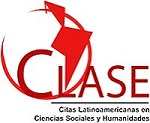Sinergias industriais de "estruturas escondidas" do conhecimento. Em direção à fundação dos ecossistemas industriais.
DOI:
https://doi.org/10.33571/teuken.v11n16a4Palavras-chave:
ecologia industrial, capacidade de absorção, redes de conhecimento, economía circularResumo
Estratégias industriais baseadas na ecologia industrial e na economia circular povoaram o cenário industrial atual. No entanto, essas abordagens que se concentram na criação de relações simbióticas entre indústrias têm sido relativamente pouco pesquisadas. Embora seja econômico e ambientalmente benéfico, o processo de seu surgimento e desenvolvimento permanece incerto. Esta pesquisa conceitual avança o papel potencial do conhecimento na criação de vínculos simbióticos por meio de uma revisão qualitativa da literatura teórica. O resultado é uma estrutura conceitual que combina diferentes correntes teóricas. Conclui-se que, usando construções como capacidade de absorção juntamente com os princípios do ecossistema industrial enquadrados na análise de redes sociais, pode-se descobrir a gênese de um ecossistema industrial.Métricas do artigo
Resumo: 554 PDF (Español (España)): 374Métricas PlumX
Referências
AGUIÑAGA, Eduardo Enrique. (2016). Creating Circular Value Ecosystems: A Regenerative Conceptual Framework Moving from Products to Systems Based on Internalizing Externalities (Doctoral dissertation). EGADE Business School, Tecnológico de Monterrey. 463 pp.
AHUJA, Gautam. (2000). Collaboration networks, structural holes, and innovation: A longitudinal study. Administrative Science Quarterly, Vol. 45, N°3. Pp. 425-455. https://doi.org/10.2307/2667105
AHUJA, Gautam & LAMPERT, Curba Morris. (2001). Entrepreneurship in the large corporation: A longitudinal study of how established firms create breakthrough inventions. Strategic Management Journal, Vol. 22, N° 6–7. Pp. 521–543. https://doi.org/10.1002/smj.176
AHUJA, Gautam & LAMPERT, Curba Morris, & TANDON, Vivek. (2008). Moving beyond Schumpeter: Management research on the determinants of technological innovation. Academy of Management Annals, Vol. 2, N°1. Pp. 1-98. https://doi.org/10.1080/19416520802211446
ANDERSEN, Mikael Skou. (2007). An introductory note on the environmental economics of the circular economy. Sustainability Science, Vol. 2, N° 1. Pp. 133-140. https://doi.org/ 10.1007/s11625-006-0013-6
ASHTON, Weslynne & BAIN, Ariana. (2012). Assessing the "short mental distance" in eco-industrial networks. Journal of Industrial Ecology, Vol. 16, N° 1. Pp. 70-82. https://doi.org/10.1111/j.1530-9290.2011.00453.x
BARRETO, Ilídio. (2010). Dynamic capabilities: A review of past research and an agenda for the future. Journal of Management, Vol. 36, N° 1. Pp. 256-280. https://doi.org/ 10.1177/0149206309350776
BELAIRE, J. Amy, DRIBIN, Andrew, JOHNSTON, Douglas., LYNCH, Douglas & MINOR, Emily. (2011). Mapping stewardship networks in urban ecosystems. Conservation Letters, Vol. 4, N° 6. Pp. 464-473. https://doi.org/ 10.1111/j.1755-263X.2011.00200.x
BORGATTI, Stephen Peter & FOSTER, Pacey. C. (2003). The network paradigm in organizational research: A review and typology. Journal of Management, Vol. 29, N° 6. Pp. 991-1013. https://doi.org/10.1016/S0149-2063(03)00087-4
BURT, Ronald Stuart. (1992). Structural Holes: The Social Structure of Competition. 1ª ed Cambridge: Harvard University Press. 230 pp.
CHERTOW, Marian Ruth. (2000). Industrial symbiosis: Literature and taxonomy. Annual Review of Energy and Environment, Vol. 25. Pp. 313–337.
CHERTOW, Marian Ruth. (2007). Uncovering industrial symbiosis. Journal of Industrial Ecology, Vol. 11. Pp. 11-31. https://doi.org/10.1162/jiec.2007.1110
CHERTOW, Marian Ruth, ASHTON, Weslynne, & ESPINOSA Juan. (2008). Industrial symbiosis in Puerto Rico: Environmentally related agglomeration economies. Regional Studies, Vol. 42, N° 10. Pp. 1299–1312. https://doi.org/10.1080/00343400701874123
COHEN, Wesley & LEVINTHAL, Daniel. (1990). Absorptive capacity: A new perspective on learning and innovation. Administrative Science Quarterly, Vol. 35, N° 1. Pp. 128-152.
COLEMAN, James Samuel. (1990). Foundations of social theory. 1ª ed. Cambridge: Belknap Press. 979 pp.
D’AVENI, Richard. (1994). Hypercompetition: Managing the Dynamics of Strategic Maneuvering. 1ª ed. New York. 210 pp.
D’AVENI, Richard, DAGNINO, Giovanni & SMITH, Ken. (2010). The age of temporary advantage. Strategic Management Journal, Vol. 31. Pp. 1371–1385. https://doi.org/ 10.1002/smj.897
DAVIS, Jason & EISENHARDT, Kathleen. (2011). Rotating leadership and collaborative innovation: Recombination processes in symbiotic relationships. Administrative Science Quarterly, Vol. 56, N° 2. Pp. 159-201. https://doi.org/10.1177/0001839211428131
DOMÉNECH, Teresa & DAVIES, Michael. (2011a). The role of embeddedness in industrial symbiosis networks: Phases in the evolution of industrial symbiosis networks. Business Strategy and the Environment, Vol. 20, N° 5. Pp. 281-296. https://doi.org/10.1002/bse.695
DOMÉNECH, Teresa & DAVIES, Michael. (2011b). Structure and morphology of industrial symbiosis networks: The case of Kalundborg. Procedia - Social and Behavioral Sciences, Vol. 10. Pp. 79-89. https://doi.org/10.1016/j.sbspro.2011.01.011
DUBEY, Rameshwar, GUNASEKARAN, Angappa & PAPADOPOULOS, Thanos. (2017). Green supply chain management: theoretical framework and further research directions. Benchmarking: An International Journal, Vol. 24, N° 1. Pp. 184-218. https://doi.org/ 10.1108/BIJ-01-2016-0011
EASTERBY-SMITH, Mark, LYLES, Marjorie & TSANG, Eric. (2008). Inter-organizational knowledge transfer: Current themes and future prospects. Journal of Management Studies, Vol. 45, N° 4. Pp. 677-690. https://doi.org/10.1111/j.1467-6486.2008.00773.x
EHRENFELD, Jonh & CHERTOW, Marian Ruth. (2002). Industrial symbiosis: The legacy of Kalundborg. In R. Ayres and L. Ayres (Eds.), Handbook of Industrial Ecology. 1ª ed. Edward Elgar, Cheltenham: UK. 562 pp.
EISENHARDT, Kathleen & MARTIN, Jeffrey. (2000). Dynamic capabilities: What are they? Strategic Management Journal, Vol. 21. Pp. 105-1121. https://doi.org/10.1002/1097-0266(200010/11)21:10/11<1105::AID-SMJ133>3.0.CO;2-E
ELKINGTON, John. (1998). Cannibals with forks: The triple bottom line of 21st century. 1ª ed. Gabriola Island, BC: New Society Publishers. 450 pp.
ELLEN MACARTHUR FOUNDATION (2012). Towards the circular economy - economic and business rationale for an accelerated transition. Greener Management International.
FROSCH, Robert Alan. (1992). Industrial ecology: A philosophical introduction. Proceedings of the National Academy of Sciences, Vol. 89, No 3. Pp. 800–803. https://doi.org/10.1073/pnas.89.3.800
FROSCH, Robert Alan & GALLOPOULOS, Nicholas E. (1989). Strategies for manufacturing. In Managing Planet Earth. Scientific American Special Issue September. Pp. 144–152.
FUJITA, Tsuyoshi. (2009). Quantitative assessment of CO2 emission reduction effects of industrial symbiosis in Japanese eco-towns. Research Presentation for International Workshop at Kalundborg, Copenhagen.
GRANT, Robert (1996). Toward a knowledge‐based theory of the firm. Strategic management journal, Vol. 17, N°2, Pp. 109-122. https://doi.org/10.1002/smj.4250171110
GENG, Yong & COTE, Raymund. (2007). Diversity in industrial ecosystems. Journal of Sustainable Development and World Ecology, Vol. 14, N° 2. Pp. 329-335. https://doi.org/10.1080/13504500709469733
GERTLER, Nicholas & EHRENFELD, Jonh. (1996). A down-to earth approach to clean production. Technology Review, Vol. 99, N°2. Pp. 48-54.
GERTLER, Nicholas & EHRENFELD, Jonh. (1997). Industrial ecology in practice: The evolution of interdependence at Kalundborg. Journal of Industrial Ecology, Vol. 1, N° 1. Pp. 1-14. https://doi.org/10.1162/jiec.1997.1.1.67
GORE, Albert Arnold “Al”. (2006). An Inconvenient Truth: The Planetary Emergency of Global Warming and What Can We Do About It. New York: Rodale. 320 pp.
HAGEDOORN, Jonh & SCHAKENRAAD, Jos. (1990). Inter-firm partnerships and cooperative strategies in core technologies. In: C. Freeman & L. Soete (Eds.), New explorations in the economics of technological change (pp. 3–37). London: Pinter Publishers.
HELFAT, Constance E. & PETERAF, Margaret. (2003). The dynamic resource-based view: Capabilities lifecycles. Strategic Management Journal, Vol. 24. Pp. 997-1010. https://doi.org/10.1002/smj.332
HOANG, Hu & ROTHAERMEL, Frank. (2010). Leveraging internal and external experience: Exploration, exploitation, and R&D project performance. Strategic Management Journal, Vol. 31. Pp. 734-758. https://doi.org/10.1002/smj.834
JELINSKI, Lynn, GRAEDEL, Thomas, LAUDISE, Robert, MCCALL, Daniel & PATEL, Charles. (1992). Industrial ecology: Concepts and approaches. Proceedings of the National Academy of Sciences, Vol. 89, N° 3. Pp. 793-797. https://doi.org/10.1073/pnas.89.3.793
KABONGO, Jean D. & BOIRAL, Olivier. (2017). Doing more with less: Building dynamic capabilities for eco‐efficiency. Business Strategy and the Environment, Vol. 26, N° 7. Pp. 956-971. https://doi.org/10.1002/bse.1958
KORHONEN, Jouni. (2001). Regional industrial ecology: examples from regional economic systems of forest industry and energy supply in Finland. Journal of Environmental Management, Vol. 63. Pp. 367–375. https://doi.org/10.1006/jema.2001.0477
KRACKHARDT, David. (1995). Review structural holes: The social structure of competition by Ronald S. Burt. Administrative Science Quarterly, Vol. 40, N° 2. Pp. 350-354.
LAURSEN, Keld & SALTER, Ammon. (2006). Open for innovation: The role of openness in explaining innovation performance among UK manufacturing firms. Strategic Management Journal, Vol. 27, N° 2. Pp. 131–150. https://doi.org/10.1002/smj.507
MARCH, James. (1991). Exploration and exploitation in organizational learning. Organization Science, Vol. 2. Pp. 71-87.
Mc DONOUGH, William & BRAUNGART, Michael. (2013). The upcycle: Beyond sustainability--designing for abundance. 1st ed. New York: North Point Press. 227 pp.
NELSON, Richard & Winter, Sidney. (2002). Evolutionary theorizing in economics. Journal of Economic Perspectives, Vol. 16, N° 2. Pp. 23-46. https://doi.org/10.1257/0895330027247
PALKO, Kathryn. (2005). Shifting the pollution problem: Recycling plastics in southern China. Halifax: Nova Scotia. 212 pp.
PAULI, Gunter. (2010). Blue Economy: 10 years, 100 innovations, 100 million jobs. New Mexico, USA: Paradigm Publications. 360 pp.
ROTHAERMEL, Frank & ALEXANDRE, María Teresa. (2009). Ambidexterity in technology sourcing: The moderating role of absorptive capacity. Organization Science, Vol. 20, N° 4. Pp. 759-780. https://doi.org/10.1287/orsc.1080.0404
SCHEEL, Carlos. (2014). Transition beyond sustainability: Breaking the paradigm, reaching economic growth from the resilience of natural resources. Paper presented at the ICTPI 2014 International Conference on Technology Policy and Innovation in Brno, Czech Republic.
SCHEEL, Carlos. (2016). Beyond sustainability. Transforming industrial zero-valued residues into increasing economic returns. Journal of cleaner production, Vol. 131. Pp. 376-386. https://doi.org/10.1016/j.jclepro.2016.05.018
SHRIVASTAVA, Paul. (1995). Ecocentric management for a risk society. The Academy of Management Review, Vol. 20, N° 1. Pp. 118-137.
STAHEL, Walter. (2010). The Performance Economy. 1st ed. London: Palgrave Macmillan. 190 pp.
SZULANSKI, Gabriel. (1996). Exploring internal stickiness: Impediments to the transfer of best practices within the firm. Strategic Management Journal, Vol. 17. Pp. 27-44.
TEECE, David. (2000). Strategies for managing knowledge assets: The role of firm structure and industrial context. Long Range Planning, Vol. 33, N° 1. Pp. 35-54. https://doi.org/10.1016/S0024-6301(99)00117-X
TEECE, David, PISANO, Gary & SHUEN, Amy. (1997). Dynamic capabilities and strategic management. Strategic Management Journal, Vol. 18, N° 7. Pp. 509-533.
VAN BERKEL, Rene, FUJITA, Tsuyoshi, HASHIMOTO, Shizuka & Fujii, Mai. (2009). Quantitative assessment of urban and industrial symbiosis in Kawasaki, Japan. Environmental Science & Technology, Vol. 43, N° 5. Pp. 1271-1281. https://doi.org/10.1021/es803319r
WALTER, Alexander & SCHOTLZ, Roland. (2006). Sustainable innovation net. works: An empirical study of interorganisational networks in industrial ecology. Progress in Industrial Ecology – An international Journal, Vol. 3, N° 5. Pp. 431-450. https://doi.ord/10.1504/PIE.2006.012270
WASSERMAN, Stanley & FAUST, Katherine. (1994). Social Network Analysis: Methods and Applications. 1ª ed. Cambridge, UK: Cambridge University Press. 223 pp.
ZAHRA, Shaker & GEORGE, Gerard. (2002). Absorptive capacity: A review, reconceptualization, and extension. Academy of Management Review, Vol. 17, N° 2. Pp. 185-203. https://doi.org/10.2307/4134351
ZHOU, Kevin & LI, Caroline. (2012). How knowledge affects radical innovation: Knowledge base, market knowledge acquisition, and internal knowledge sharing. Strategic Management Journal, Vol. 33, N° 9. Pp. 1090-1102. https://doi.org/10.1002/smj.1959
ZHU, Qinghua, LOWE, Ernest, WEI, Yao & BARNES, Dan. (2007). Industrial symbiosis in China: A case study of the Guitang Group. Journal of Industrial Ecology, Vol. 11. Pp. 31-42. https://doi.org/10.1162/jiec.2007.929
ZHU, Qinghua & COTE, Raymond. (2004). Integrating green supply chain management into an embryonic eco-industrial development: A case study of the Guitang Group. Journal of Cleaner Production, Vol. 12 N°, 8. Pp. 1025–1035. https://doi.org/10.1016/j.jclepro.2004.02.030

























